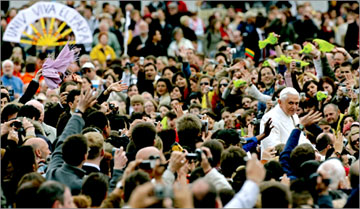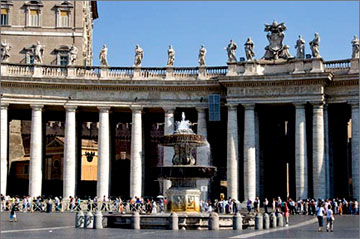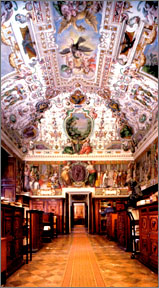Great cultural significance
The Vatican City :
|

VATICAN CITY STATE : Pope Benedict XVI is greeted by Catholics as he
arrives in St. Peter's square to celebrate his weekly open-air
general audience at the Vatican ApriL 4. The first volume of a work
on Jesus written by the pontiff will be published this month on the
pope's 80th birthday, the Vatican announced 04 April. The book will
be released simultaneously in Italy, Germany and Poland. AFP
|
The Vatican City is the smallest independent sovereign state in the
world with government, statutes and head of state of it's own.
Although it covers just a few acres of land, it holds within its
boundaries the residence of the Pope, the site of St. Peter's Basilica,
the Vatican Museums and the Sistine Chapel.
It was created in 1929 by the Lateran Treaty as a vestige of the much
larger Papal States (756 to 1870). Vatican City is a non-hereditary,
elected monarchy that is ruled by the Bishop of Rome ? the Pope. The
highest state functionaries are all clergymen of the Catholic Church.
It is the sovereign territory of the Holy See (Latin: Sancta Sedes)
and the location of the Apostolic Palace, the Pope's official residence,
and the Roman Curia.
Thus, while the principal ecclesiastical seat (Cathedral) of the Pope
as Bishop of Rome (the Basilica of St. John Lateran) is located outside
of its walls, in Rome, Vatican City can be said to be the governmental
capital of the Catholic Church.
The Vatican City, one of the European microstates, is situated on the
Vatican Hill in the west-central part of Rome, several hundred metres
west of the Tiber river. Its borders (3.2 km or 2 miles in total, all
within Italy) closely follow the city wall constructed to protect the
Pope from outside attack.
|

Vatican City
|
The situation is more complex at the famous St. Peter's Square in
front of St. Peter's Basilica, where the correct border is just outside
the ellipse formed by Bernini's colonnade, but where police jurisdiction
has been entrusted to Italy. The Vatican City is the smallest sovereign
state in the world at 0.44 square kilometres (108.7 acres).
The Vatican climate is the same as Rome's; a temperate, Mediterranean
climate with mild, rainy winters from September to mid-May and hot, dry
summers from May to August.
There are some local features, principally mists and dews, caused by
the anomalous bulk of St. Peter's Basilica, the elevation, the fountains
and the size of the large paved square.
The Vatican City is itself of great cultural significance. Buildings
such as St. Peter's Basilica and the Sistine Chapel are home to some of
the most famous art in the world, which includes works by artists such
as Botticelli, Bernini and Michelangelo.
The Vatican Library and the collections of the Vatican Museums are of
the highest historical, scientific and cultural importance.
In 1984, the Vatican was added by UNESCO to the List of World
Heritage Sites; it is the only one to consist of an entire country.
Furthermore, it is the only site to date registered with the UNESCO
as a centre containing monuments in the "International Register of
Cultural Property under Special Protection" according to the 1954 Hague
Convention for the Protection of Cultural Property in the Event of Armed
Conflict.
|

Saint Peter’s Basilica
|
Saint Peter's Basilica Built in 1506 over St. Peter's tomb remains,
Saint Peter's Basilica is the world largest Basilica. In 1547
Michelangelo took over and simplified Bramante's previous plan,
increasing the scale.
At his death in 1954, one of Michelangelo's students, Giacomo della
Porta, looked after the erection of the Dome following the master's
design. Magnificent sculptures from Bernini, Michelangelo and many other
great "Maestri" can be admired in the Basilica.
In the Basilica you can also visit the Treasury; the Vatican Grottoes
and the Dome. Vatican museums
The Vatican Museums comprise the papal apartments of the medieval
apostolic Palace, frescoed during the Renaissance, the Sistine Chapel,
the Vatican Apostolic Library, and the Museums themselves.
The first actual Museums (the Pio-Clementine Museum, the Gallery of
the Candelabra, the Chiaramonti Museum and the Inscription Gallery),
devoted to classical Greco-Roman statuary, were founded by the popes of
the 18th and 19th centuries and later enlarged in the 18th Century, with
the construction of new buildings inspired by the Roman Imperial
architecture.
In the 19th century three other Museums were created by pope Gregory
XVI
* The Etruscan Museum , which contains 18 rooms of Etruscan artifacts
and Greek statuary
* The Egyptian Museum, cointaining statues brought from Egypt in the
imperial age
* The Tapestry Gallery where tapestries by Raphael's school can be
admired In the 20th century, the Vatican collection was rearranged in
the Pinacoteca, a new building set aside for the purpose.
Later on, in 1973, three other collections were arranged in the same
building:
* The Profane Gregorian Museum, containing classical statuary
* The Pio-Christian Museum, containing works from the excavation of
catacombs
* The Missionary-Ethnological Museum, housing works from
extra-European cultures Both the Sistine Chapel and the "Raphael's
Rooms" are a 20-30 minute walk from the Museums' entrance. As they are
very crowded you'd better arrive very early in the morning.
Courtesy Internet
|
